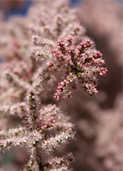
Salt Cedar invades
Salt Cedar, or Tamarisk, is an invasive deciduous shrub and small tree. Originally brought over from the Mediterranean as an ornamental and windbreak, it can quickly replace native flora. Tamarisk provides poor habitat for livestock, wild animals, and birds, as the foliage and flowers of Tamarisk provide little food value for native wildlife species that depend on nutrient-rich native plant resources.
Invasive Species
Invasive plants have a significant effect on native species throughout California. In the California desert, invasive plants compete for resources, such as water and soil nutrients, and can produce allelopathic chemicals that inhibit the growth of native plants in the surrounding area.1 Invasive plants also disrupt natural fire regimes. In riparian areas, invasive plants, such as saltcedar (Tamarix spp.), are serious competitors for water with native vegetation and wildlife species. The colonization of natural areas by non-native plants has been facilitated by transportation corridors and habitat disturbances such as OHV recreation, livestock grazing and agriculture.2
1 J.E. Lovich and D. Bainbridge, “Anthropogenic Degradation of the Southern California Desert Ecosystem and Prospects for Natural Recovery and Restoration,” Environmental Management 24, no. 3 (1999): 309-326.
2 M.L. Brooks, “Spatial and Temporal Distribution of Nonnative Plants in Upland Areas of the Mojave Desert,” in The Mojave Desert: Ecosystem Processes and Sustainability, ed. R.H. Webb, L.F. Fenstermaker, J.S. Heaton, D.L. Hughson, E.V. McDonald, and D.M. Miller, (Reno: The University of Nevada Press, 2009), 101-124.
